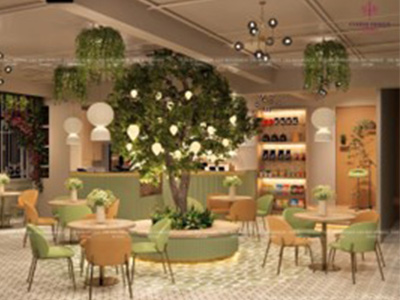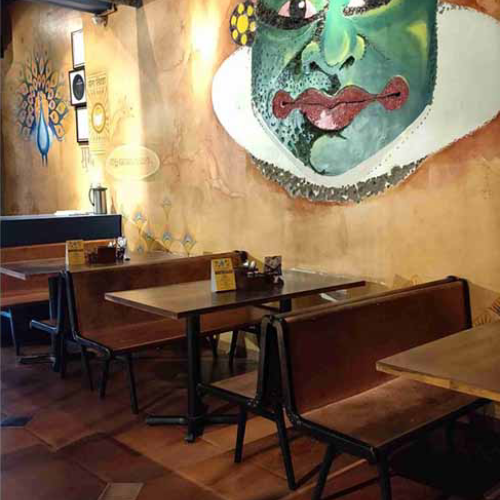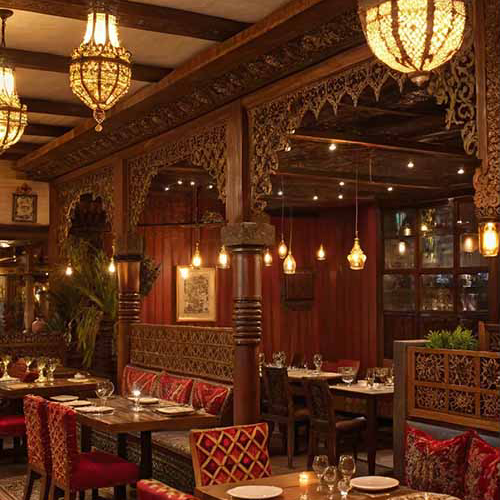- Home Owner Bangalore -
- Home Owner Kolkata -
- Other Enquiry -
Restaurant Interior Design

Introduction
Dining ambiance is vital to the customer experience because it engages all five senses to create a powerful emotional connection that directly influences satisfaction, spending, and loyalty. The best restaurant interior design isn’t just about looks, it’s about creating an experience that keeps customers coming back. Well-planned interiors reflect a restaurant’s brand identity, making it distinctive, memorable, and capable of leaving a lasting impression on every guest.
Best Restaurant Interior Design Principles
The best interior design principle mainly focuses on coherent and functional experiences,ambience, comfort and brand consistency. The key elements include the following;
- Lighting & Mood: Blend natural and artificial lighting to create balance, enhance ambiance, and draw attention to key focal areas.
- Furniture & Seating: Focus on comfort, ergonomics, and adaptable arrangements to elevate the overall dining experience.
- Color Psychology: Use warm tones to encourage appetite and lively interaction, while cool tones promote calmness and sophistication.
- Layout Flow: Ensure a seamless transition from the entrance to the dining, kitchen, and service areas, allowing for efficiency, guest comfort, and smooth movement throughout the space.
- Food-Centric Design: Ensure that interiors enhance the dining experience without overpowering the food itself, the presentation and flavors should remain the star of the show.



Contemporary Restaurant Interior Design
Contemporary interior design is a flexible, evolving style that adapts to current trends while drawing inspiration from various design movements. Its highlights include:
● Minimalist Furniture & Open Layouts: Sleek, clean lines and uncluttered spaces with open floor plans that promote a modern, airy atmosphere.
● Industrial Touches: Elements like exposed brick, raw concrete, and metal accents that add character and an urban edge.
Tech-Driven Dining Experience: The use of digital menus, smart lighting, and interactive features to enhance both convenience and ambiance.
Cuisine-Specific Restaurant Interiors: Cuisine-specific restaurant interiors are a restaurant’s interior design that is intentionally crafted to reflect and complement the specific cuisine being served, creating a cohesive and immersive dining experience that aligns with the food’s cultural or geographical origin.
Indian Restaurant Interiors:
Indian restaurant interiors are deeply rooted in tradition, featuring intricate motifs, jaali panels, and the use of wood, brass, and ethnic art pieces. Together, these elements create a divine atmosphere and a culturally rich environment that celebrates heritage.




Chinese Restaurant Interiors:
Chinese interiors are often defined by red and gold palettes paired with lantern-style lighting, symbolizing prosperity and warmth. In restaurant design, these elements are enhanced by Feng Shui principles, which ensure balance, harmony, and a welcoming dining experience.


Biryani Restaurant Interiors:
Biryani restaurants typically embrace a rustic and casual vibe that aligns with the comfort food they serve. The use of affordable, durable materials supports quick service and high customer turnover, while murals and subtle cultural touches highlight food heritage.


Fusion & Themed Restaurant Interiors:
Fusion and themed interiors experiment with Bollywood-inspired wall art, rustic dhaba-style seating, and eclectic global design influences. This style is particularly appealing to younger diners who seek unique, vibrant, and memorable dining experiences.


How Cuisine & Culture Shape Restaurant Interior Design
Cuisine and culture deeply influence restaurant interior design, creating a visual narrative that complements the dining experience and reflects cultural storytelling.
Regional Variations in Indian Restaurant Interiors
Indian restaurant interiors vary widely depending on region and cuisine:
- South Indian Restaurants: Anyone who has experienced South Indian cuisine knows the heart of the meal is served on a banana leaf. Interiors often incorporate temple-inspired artwork, earthy stone textures, and traditional wooden finishes, creating a serene and spiritual ambiance.
- North Indian/Mughlai Restaurants: These spaces are defined by rich jewel tones, ornate arches, chandeliers, and intricate carvings, evoking grandeur and royal heritage.
- Street-Food Style / Café Fusion: Featuring bold murals, neon lighting, and quirky seating, these interiors foster an energetic, youthful atmosphere that resonates with casual dining and social experiences.
- Japanese Restaurants: Interiors focus on minimalism, natural materials, and simplicity, reflecting the Zen philosophy central to Japanese culture. Light wooden furniture, tatami-style seating, paper lanterns, and subtle textures create a calm, balanced, and intimate dining environment, emphasizing precision and harmony in both design and cuisine.
Fusion & Themed Restaurant Interiors
Fusion and themed restaurants are growing in popularity, with interiors that reflect imaginative and eclectic design approaches:
- Bollywood-Inspired Décor: Wall posters of iconic movies and actors, famous dialogues, and vibrant graphics add cinematic flair and a sense of nostalgia.
- Rustic Dhaba-Style: Benches, charpai-inspired seating, and colorful enamelware create an authentic roadside or biryani-dhaba vibe.
- Global Fusion: A mix of industrial, rustic, and contemporary design elements caters to younger diners seeking unique, memorable, and Instagram-worthy experiences.
Experience-Oriented Dining Spaces
Modern diners seek more than just food, they crave an immersive dining experience.
- Interactive Kitchens: Live cooking stations for biryani, tandoor, or wok dishes create a theatrical and engaging atmosphere, allowing guests to connect with the culinary process.
Cultural Storytelling: Wall art and décor can narrate culinary journeys, such as the Silk Road for Arabic cuisine, Chinese calligraphy for traditional dishes, or India’s spice trail, immersing guests in the rich heritage behind each meal.
Luxury Fine-Dining vs. Casual Dining in Cuisine Interiors
Restaurant design aesthetics shift significantly based on market positioning:
- Luxury Indian Fine-Dining: These spaces create an immersive, elegant experience with plush seating, rich textures, and premium materials like marble, polished wood, and brass accents. Layered ambient lighting highlights decor and table settings, while curated design elements such as chandeliers and art pieces add sophistication. Spacious layouts ensure privacy and smooth service, making every meal a memorable experience where design complements, but never overpowers,


- Casual Dining: These spaces prioritize approachability, comfort, and efficiency. Interiors use durable materials, flexible seating, and smart layouts to support high turnover while keeping diners relaxed. Decor often reflects cultural themes, local flavors, or playful elements, creating energy, vibrancy, and a sense of community. The lighting is bright yet welcoming, and every design choice balances functionality with a fun, social dining experience.
Acoustic Design & Smell Management
Practical elements can elevate comfort as much as aesthetics:
- Acoustic Panels: Reduce noise in high-traffic spaces, ensuring conversations aren’t drowned out.
- Air Circulation & Scent Zoning: Essential for cuisines like Indian, Chinese, and biryani, where strong aromas can otherwise overwhelm guests. Proper ventilation ensures freshness while maintaining appetizing scents.
Commercial Restaurant Interior Design
Commercial restaurant interior design is crucial for chains and franchises as it builds a compelling brand identity while ensuring scalability. This approach emphasizes extendable design concepts that balance cost-efficiency with branding consistency, directly driving business success through increased customer footfall. The objective is to establish a recognizable identity across multiple locations while optimizing layouts, materials, and finishes for long-term durability and operational efficiency.
Tips for Designing a Unique Restaurant Interior
The psychology behind restaurant interior design is to create spaces that engage guests both aesthetically and physically. A well-designed restaurant should evoke a sense of comfort, relaxation, and delight the moment guests walk in. This can be achieved by fulfilling the following purposes:
- Balance brand identity, customer comfort, and Instagram-worthy moments: Create an environment that is both memorable and practical, leaving a lasting impression on diners.
- Incorporate sustainable materials and thoughtful lighting: Enhance ambiance while promoting environmentally responsible practices.
- Collaborate with professional interior designers: Ensure design concepts are executed seamlessly and strategically aligned with business objectives.
Conclusion
Restaurant interiors are more than just decor—they shape experiences. By engaging all the senses, a well-designed space boosts footfall, delights guests, and keeps them coming back for more. Every detail is crafted to make dining memorable.
Call to Action
Ready to transform your restaurant? Whether modern, Indian, or luxury dining, CeeBee Design Studio designs spaces that combine style, functionality, and an unforgettable ambiance.
Speak to us:
Follow us on:
About us
Welcome to CeeBeeDesignStudio, an Indian homegrown interior design brand where every home is a canvas and every design is a story.
We’ve proudly completed over 1000 residential and 400 commercial projects across 7 cities, earning a reputation for unmatched aesthetic acumen and client satisfaction. Our studio has also been recognized with multiple national awards, a reflection of our commitment to excellence, storytelling, and design innovation.
From thoughtfully styling modern apartments to restoring heritage homes, we bring soul, sustainability, and structure into every project.
Enter Your Details
About Us
CeeBeeDesignStudio is one of the fastest growing interior execution companies. Currently we have very strong presence in Bangalore, Goa, and Kolkata. Our motto is to keep the clients requirement and budget in mind and give a qualitative result on time.
Quick Link
Contact Info
- Door No-18, 3rd B Cross, Domlur II Stage, Bangalore 560071
- +91 8697306015
- chitralekha@ceebeedesignstudio.com
Contact Info
- 3045 Rajdanga main road, Kolkata, West Bengal 700107
- +91 8697306015
- chitralekha@ceebeedesignstudio.com
- Copyrigt © 2025 CeeBeeDesignStudio Pvt. Ltd

